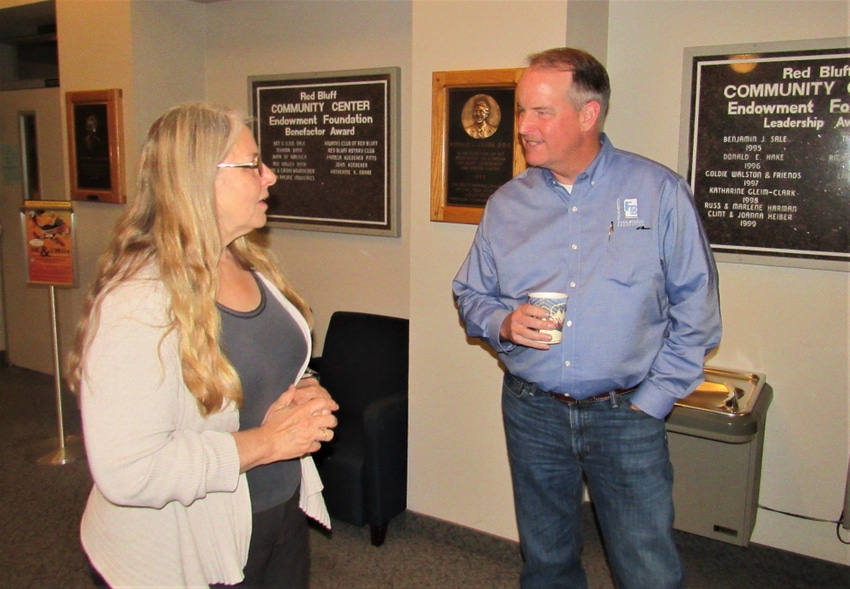
For Jamie Johansson, a Farm-City Night celebration in Red Bluff, Calif., in early November was the perfect place to talk about the importance of communication – both among farmers and with the public.
“It’s easy a lot of times in agriculture to talk about San Francisco, Sacramento or Washington, D.C.,” says the first-generation olive and citrus grower from Orland, Calif. “We often forget with our changing communities that people in our own backyards don’t know what you do.”
Johansson is in a position to communicate agriculture’s needs and benefits. He was chosen last December as the California Farm Bureau Federation’s 16th president, succeeding Modesto tree nut grower Paul Wenger, and has made it a point to promote the importance of advocacy and diligent pursuit of the organization’s mission.
He’ll have the distinction of leading the statewide Farm Bureau’s 100th annual meeting Dec. 4-7 in San Diego.
“It’s humbling from the standpoint of just what Farm Bureau has withstood to sustain its membership,” Johansson tells Western Farm Press in an interview.
KEEPING AGRICULTURE VIABLE
“We have to stay focus on keeping ag viable,” he says. “The most important thing we do in Farm Bureau is have communication with our members and with legislators, being able to communicate with members so they can reach out to their leaders. Also, pushing back on those voices that claim to speak for agriculture but don’t understand what needs to happen on the farm and how diverse we need to be to survive.”
Growing up in Humboldt County, Johansson would have had no inkling that he’d someday run the state’s largest agricultural organization, which now has about 25,000 members -- not even after majoring in political science at Colorado State University.
His interest in agriculture was formed when he took an FFA class in his senior year of high school. “That’s where the dream started,” he says. “I knew I wanted to be involved in agriculture, but I’d never had the chance.”
That chance came when he bought 20 acres of olive trees in 1993. He contracted with a local cannery for table olives, but when the cannery went out of business, Johansson had his first taste of adversity.
“It was my first experience with the volatility of markets,” he says. “I knew I needed to get bigger and diversify with an added-value commodity.”
OLIVES FOR OIL
Johansson, wife Nicole and three children now have 80 acres of olives for oil, specialty citrus fruit and an egg operation, mostly sold directly to consumers. Among local activities, he co-founded the Sierra Oro Farm Trail Association and is a former Oroville city councilman.
“I didn’t know anything about Farm Bureau until I started farming,” Johansson says. “I went back to Humboldt County and a dairyman told me I needed to join Farm Bureau. I needed to give back to the people who gave me an opportunity to farm. Then I realized I had something to say.”
Johansson was elected second vice president of the CFBF in 2009 and first vice president in 2015. As president, he serves alongside first vice president Shannon Douglass of neighboring Glenn County, and second vice president Shaun Cook of Sonora. Douglass raises beef cattle and several field crops and Cook is a timber operator.
For the trio, 2018 has been a tumultuous year, as U.S. trade disputes with China and other nations have caused economic uncertainty in an industry that relies heavily on exports. A report released this summer by the University of California’s Agricultural Issues Center estimated that higher tariffs could cost major U.S. fruit and nut industries $2.64 billion per year in exports to countries imposing the higher tariffs, and as much as $3.34 billion by reducing prices in alternative markets.
MORE OPPORTUNITIES
But the reliance on exports also bodes well for future opportunities in California agriculture. During his remarks at the Red Bluff dinner, Johansson noted that the total gross value of Tehama County agricultural production in 2017 was a record $381.7 million – about a $46.5 million increase from 2016 total values.
“You exported to over 60 countries,” Johansson told the growers. “That means 60 countries came here to get something to eat.”
Farm-city celebrations are more important than ever, as in 2008 the urban population surpassed the rural population worldwide. “We know the world population in 2050 is going to be 9 billion people. We in agriculture will have to produce as much food as agriculture has produced since 10,000 B.C.”
As more people move into the middle class globally, those consumers will want premium meat, dairy products and tree nuts – all California specialties, he added. That will create more jobs in processing, he says. “There’s never been so many opportunities in agriculture.”
Noting that the number of commodities grown in California has doubled to more than 400 over the last several decades, Johansson says, “The opportunities have never been greater because we are so diverse.”
While fewer than 1 percent of California residents farm, they produce more than they ever have before, he says. That productivity produces jobs; Johansson cites a U.S. Department of Labor study that asserts that 50,000 jobs in agriculture go unfilled every year.
However, while 1 in every 3 new jobs were in rural America during President Bill Clinton’s administration, that had decreased to 1 in 10 jobs starting in rural America by 2009, he says.
“Rural America is being forgotten,” he told the gathering. “There’s hope on the horizon but we need your help. We have to keep these farm-city celebrations going.”
About the Author(s)
You May Also Like






